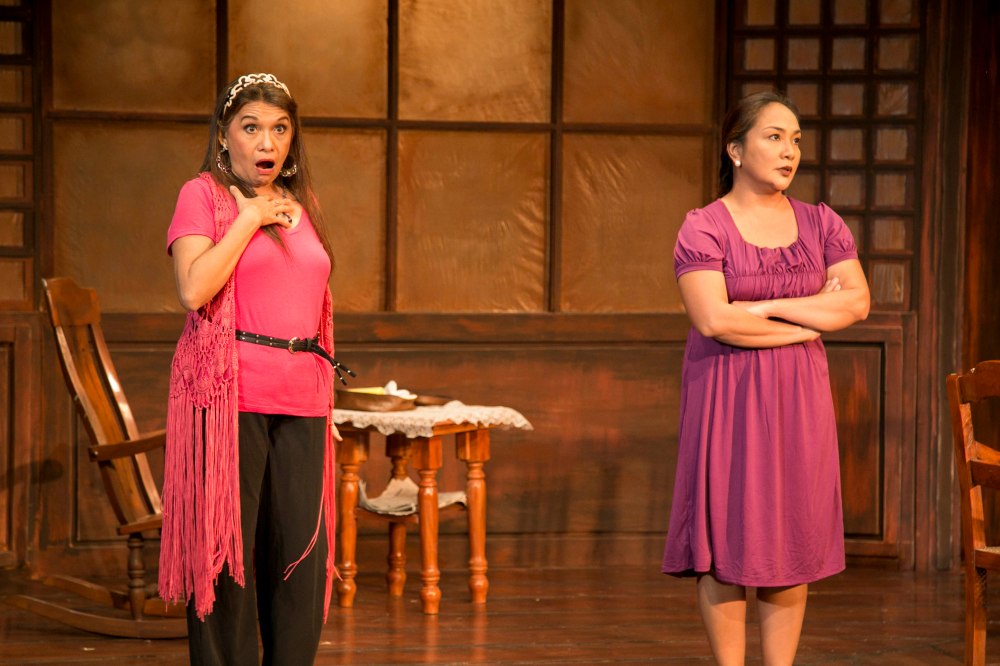
What do you get when a Nick Joaquin classic gets translated by Virgilio Almario and Jose Lacaba, directed by Tony Mabesa, and brought to life by veteran thespians like Leo Rialp and Rody Vera?
For the opening salvo of its 42nd season, Dulaang UP stages Fathers and Sons – a powerful work of not just one, but two, National Artists.
Set in the 70’s, Fathers and Sons (Mga Ama, Mga Anak) is a story of patriarchy. The central figure is Zacarias Monzon, a man of many wives and concubines, a tomador and tango dancer, embezzled with a latigo that furthered his power in a meek household.
Zacarias was once an influential caritela owner but now spends his last days in the company of a whore who found first love in his arms – much to the dismay of his son.

The story opens with Zacarias being a weak, sleepy, old man until a mysterious substance was injected by a loud and taklesa community nurse. The substance awakens him, and an hour and a half of family conflict unravels.
The play slowly but masterfully advances from one scene to another – giving it a tension-filled build-up as more characters join onstage, with occasional punch lines dotting the otherwise heavily dramatic production.
Characters reveal their backstories in the appropriate time and each of them were given a moment to show their struggles.
In his final moments, Zacarias finds solace with Bessie, a beerhouse dancer who was ‘raised not as a woman, but as merchandise’. Hers was a two-pronged character. On one side, she subverts and questions the patriarchal ways, and on the other, she satisfies it. While she finds fulfillment in the Monzon home, she has the balls to question Marcelo’s (Zacarias’ son) decision to drive her away. She puts up a fight, but was eventually forced to leave. She returns when she was called back, an act of defiance in a home bred in violence and brutality.

Objects weren’t just mere props as it signify power – from long imaginary tables that served as Zacarias’ pseudo-throne to the whip that perpetuated violence in the patriarchal household. The denouement comes with the old man’s sudden death – pivoting the story one hundred eighty degrees. The ending image was harrowing, and I am leaving it for you to see and discover.
Martial Rule
Fathers and Sons was written in 1977, at the height of Martial Law, but it still reflects most patriarchal families today. In a society where strong men still rule and where violence still persist, it is easy to be aggressive and abusive. The play then raises a lot of relevant questions. Is brutality genetic? Can we pass on our cruel ways to the children of our children?

Chitong, the confused novice for priesthood and Zacarias’ grandson, opines rightfully when he said that character isn’t something inherited, but created. In the end, we choose our own demons.
It is intrinsic for the Filipino family to be tightly-knit and sometimes it takes a painful death for us to realize that injustices exist inside our homes.
The three-act play is an obra of Dulaang UP’s founding director Tony Mabesa – who is among the greatest living icons in Philippine Theatre. The play’s genre – old school drama, is undoubtedly his turf. As expected, Fathers and Sons does away with the glitz and glamour and the fancy spectacles. Its strength is in the powerful acting of its ensemble.
Power Cast
Rody Vera, a renowned playwright and film writer, surprised the audience with his acting prowess. He plays Marcelo, Zacarias’ son, and heir to his iron fist and strong persona. He rebels against his father’s ways but end up worse. Vera’s anger reverberates in the hallowed walls of the Guerrero Theatre, his pauses and silence too deafening. Marcelo owes his commanding character to his father Zacarias, played alternately by seasoned actors Leo Rialp and Menggie Cobbarubias.



Injecting humor to the story are Candy Pangilinan who plays Bessie (the whore) and Prof. Belen Calingacion who plays Mrs. Paulo (the nurse). Stella Canete, Banaue Miclat-Janssen, Carlo Tarobal and their alternates complete the cast. Whoever casted the set of actors could not have done a more brilliant job.
In the end, Fathers and Sons returns to what Dulaang UP does best – producing enigmatic literary classics atypical of commercial productions. And in a theatre scene dominated by glamorous musical extravaganzas, Fathers and Sons is another rare find.

Editor’s Note: Fathers and Sons runs for 80 minutes. It will be staged by Dulaang UP at the Wilfrido Ma. Guerrero Theater from September 6 to 24, 2017.
[Entry 239, The SubSelfie Blog]
About the Authors:
Jervis Manahan is a News Reporter for PTV 4. He is a Contributor forSubSelfie.com and part of the original roster that founded the site. He was previously a News Writer for 24 Oras and Unang Balita, and a News Researcher for State of the Nation with Jessica Soho. Broadcast Communication 2012, UP Diliman. Read more of his articles here.

Roman Esguerra is a freelance multimedia specialist. He is exclusively working for nonprofit organization Save the Children as a videographer, graphic designer and photographer since 2015. Multimedia Arts and Sciences- Mapúa University 2015.


I have seen “Mga Ama, Mga Anak” staged by PETA at the Fort back when I was still in high school. It added fuel to my growing interest in theater that it even helped me decide to take Theater Arts as my major back in college. I would love to see this version collaborated by two of our National Artists…
LikeLike